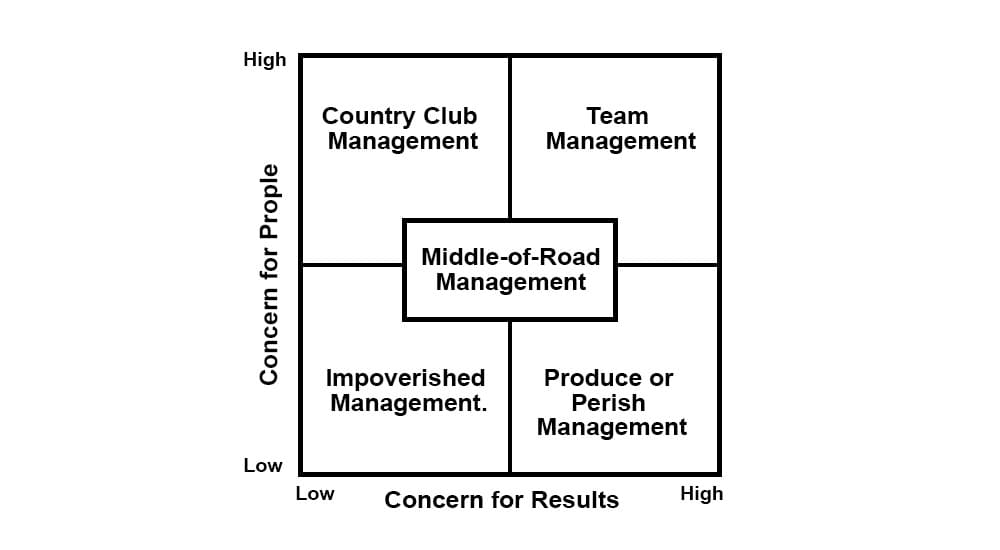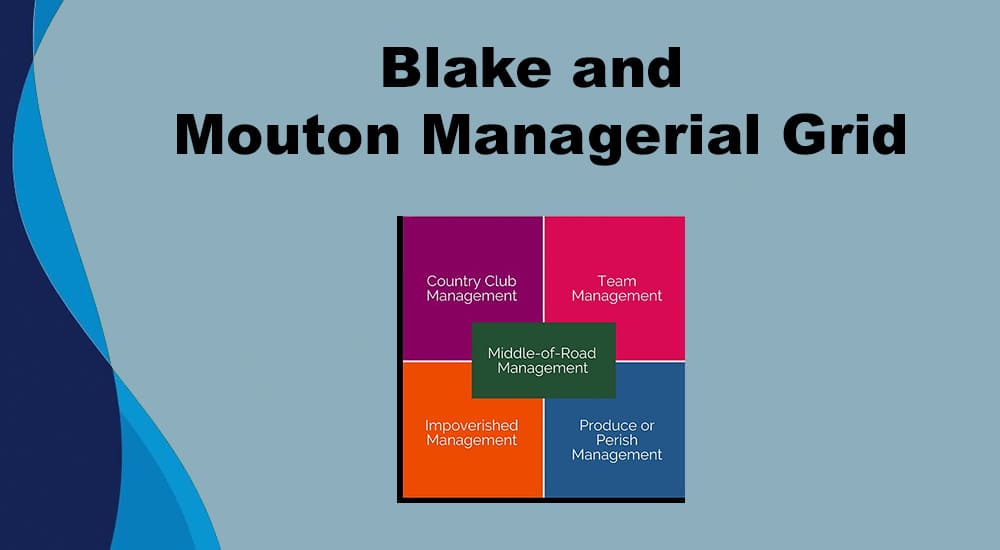In the early 1960s, two professors from the University of Texas at Austin, Robert Blake, and Jane Mouton, developed a managerial effectiveness theory known as the Blake and Mouton Managerial Grid. The grid is a tool that helps managers understand how to manage their team to achieve the best results.
This blog post will discuss the Blake and Mouton Managerial Grid and how a business can use this tool to improve efficiency.
What is the Blake and Mouton Managerial Grid?
The Blake and Mouton Grid helps managers assess their management style and find areas for improvement.
Once a manager understands their position on the grid, they can improve their weak areas. A people-oriented manager who struggles with meeting production goals can focus on learning about the business and how it works.
Alternatively, if a production-oriented manager struggles with maintaining team morale, they can focus on developing relationships with their team and understanding their needs.
The Blake and Mouton Managerial Grid model describes the different managerial styles by looking at two dimensions: concern for people and concern for results.
The managerial grid has two axes, concern for people and production, and each axis has two options, people-oriented and production-oriented.
The people-oriented manager focuses on the team and creates a positive work environment.
The production-oriented manager is focused on meeting goals and getting things done.
Managers fall along these two axes, and each position has its strengths and weaknesses.

The grid has four quadrants with different management styles.
- The first quadrant is “Producer” or “Produce-or-perish.” Here, managers care more about results than people. They are often called “Command and Control” because they like to be in charge and give orders.
- The second quadrant is “Team Player.” Here, managers are concerned with people and results. These managers are often called “Participative” because they involve employees in decision-making.
- The third quadrant is “Country Club.” Here, managers are more concerned with people than with results. They are often called “Laissez-faire” because they leave employees alone to do their work.
- The fourth quadrant is “Impoverished.” Here, managers are not concerned with people or results. They are often called “Micromanagers” because they like to be involved in employee work details.
Using the Blake and Mouton Managerial Grid
The following steps are required to use the grid.
Step One: Assess the Management Style
Managers should consider how they handle situations. Are they result-oriented or care about people? A look at the grid can help them understand their management style.
Step Two: Identify the Goals
Managers should consider what they want to accomplish with their team. Are they looking to increase production, or are they concerned with employee satisfaction? Understanding goals can align them with their management style.
Step Three: Find Their Position on the Grid
After understanding management style and goals, the next step is to find their position on the grid. This will help to identify areas for improvement. After figuring out one’s management style, identify strengths and weaknesses.
Managers can find their styles, weaknesses, and strengths by reviewing the situations they have managed. If a people-oriented manager struggles with meeting production goals, they should focus on production for improvement.
Step Four: Develop a Plan of Action
After identifying the areas for improvement, develop a plan of action. This plan should include specific steps required to improve their weak areas.
Managers can also choose a focus area. This is the area where managers have to make improvements. It might be communication, delegation, problem-solving, etc.
Step Five: Put the Plan Into Action
Putting the plan into action means learning and practicing new skills. It also means learning to manage certain situations differently. For example, if a manager is people-oriented and struggles with delegation, they should start distributing tasks.
The Managerial Styles
The Blake and Mouton Managerial Grid classifies five managerial styles based on concern for production (results) and people (relationships).
1. Country Club Management
This management style has a high concern for people and low concern for production. Managers with this management style are concerned about their employees’ harmony and well-being.
These managers are more interested in developing relationships with their employees than in meeting deadlines or producing results. They are certain that meeting workers’ requirements will boost performance since everyone will be pleased and satisfied.
Country club managers focus more on people than work output. Consequently, the work environment is friendly and relaxed but not particularly productive.
2. Team Management
These managers have a high concern for employees and work output. They focus on getting the job done and maintaining a productive team.
Team managers are task-oriented and set high standards for their employees. They want their team to be successful both professionally and personally. They often show toughness to get results but care about the welfare of their workers.
These managers prioritize productivity while maintaining a positive relationship with their employees. This style can be demanding but also results-oriented.
3. Middle-of-the-Road Management
This style is characterized by a moderate concern for people and production. Middle-of-the-road managers are neither task- nor people-oriented; instead, they focus on meeting the needs of both groups. They strive for a balance between the two dimensions.
Middle-of-the-road management results in neither dramatic productivity nor moral problems. However, this style can also be seen as uninspiring and ineffective.
4. Task Management or Producer Management Style
This management style has a high concern for production and low concern for people.
Producer managers are results-oriented and see their employees as not valuable but required to achieve the aim.
They are focused on meeting deadlines and results and often use strict rules to control and achieve goals. These managers may be insensitive to the needs of employees, which can lead to high stress and low morale.
The producer management style is often demanding and stressful, but it can effectively meet productivity goals.
5. Impoverished Management Style
In this style, managers have little concern for their employees and the work output. High levels of stress and turnover often characterize this style.
These managers don’t connect with employees and do not set high standards for work output. Hence, the work environment is chaotic and unproductive, with little motivation to improve performance.
An impoverished management style is damaging to an organization and should be avoided.
Pros of the Blake and Mouton Managerial Grid
The benefits of the Blake and Mouton Managerial Grid include:
- Improved Communication and Better Understanding: The grid creates a common language for understanding managerial styles. It helps prevent misunderstandings and promotes better communication.
- Effective Decision Making: The grid helps managers assess the situation and make informed decisions. They can better understand the trade-offs involved in different decisions.
- Improved Team Productivity: The grid helps create a productive and harmonious work environment. It helps identify and manage conflict and establish clear goals and expectations.
- Increased Motivation in the Workplace: Employees who feel that their manager understands and is involved with them are motivated and perform well.
- Enhanced Teamwork: Managers can help create a team environment where everyone can work together harmoniously. The grid can help create a more cohesive team by providing a framework for understanding different roles and responsibilities.
- Reduced Stress and Conflicts in the Workplace: When used correctly, the grid can help minimize stress and conflict in the workplace. It can provide a structure for dealing with disagreements and help to create a positive work environment.
- Helps Identify Leadership Styles and Loopholes: The grid can help identify the different leadership styles and how they can be used most effectively. It highlights the potential problems with each style, allowing managers to avoid them.
Cons of the Blake and Mouton Managerial Grid
The disadvantages of the Blake and Mouton Managerial Grid include:
- It Can be Difficult to Use: The grid can be challenging, particularly for those unfamiliar with it. This can lead to problems when applying the tool to real-world situations.
- It May Not be Accurate: The Blake and Mouton Managerial Grid is based on many assumptions that may not always hold true in reality. The grid may not be accurate for decision-making purposes.
- It Can be Time-consuming: The Blake and Mouton Managerial Grid can be time-consuming when applied to a complex situation. This can lead to delays in making decisions.
- It May Not be Applicable in all Situations: The Blake and Mouton Managerial Grid is not applicable in all situations. This is not the best tool for decision-making.
- The Model Does Not Take Context Into Account: The Blake and Mouton Managerial Grid does not take context into account when making decisions. Leaving the context out can lead to serious issues.
- It Can be Difficult to Interpret Results: Sometimes, it is difficult to determine the results of the Blake and Mouton Managerial Grid.
Examples of the Blake and Mouton Managerial Grid
Example of Country Club Management
Let’s take an example of a restaurant where the manager follows a country club management style, and employees fall under the “supportive” category.
This management style focuses on maintaining good relationships with customers and employees.
The manager uses a democratic leadership style, which is goal-oriented and participative. This leadership is beneficial because it allows employee input, leading to better decision-making.
The goal of the country club management style is to create a harmonious and productive work environment. However, this might impact work output since the manager is not keen on holding employees accountable.
Example of Task Management or Producer Management Style
Let’s take the example of a call center. The call center employees would fall under the “task-oriented” category.
The task-oriented managerial style focuses on getting work done efficiently and meeting deadlines without focusing on the people aspect.
The manager uses an autocratic leadership style, which is directive and unyielding. This type of leadership style is beneficial because it allows for quick decision-making.
The goal of the task-oriented managerial style is to produce results. However, this might impact employee satisfaction and morale since the manager is not keen on input from employees.
Conclusion
The Blake and Mouton Managerial Grid is a model to assess the management style of managers. The right management style helps determine employee roles, organizational structure, goals, decisions, resource allocation, etc. It helps businesses develop and grow.
The grid helps with understanding different management styles and improves communication within organizations.
